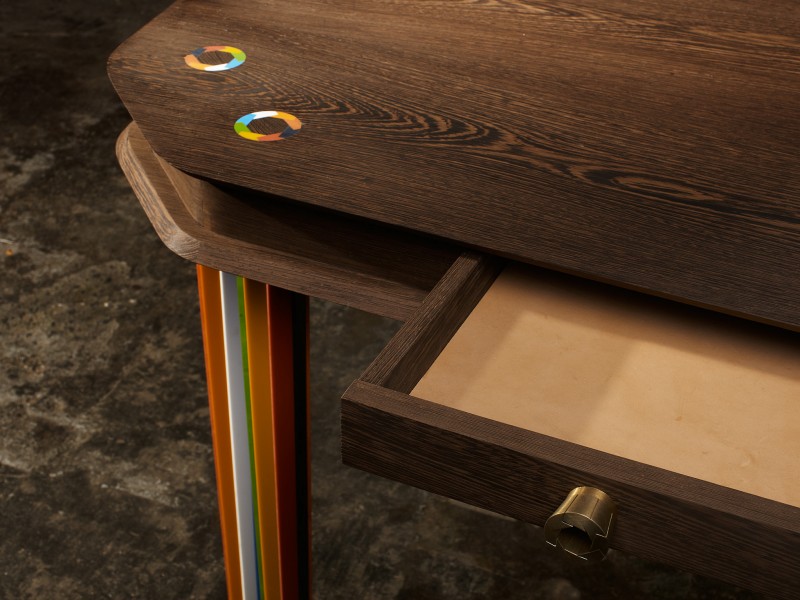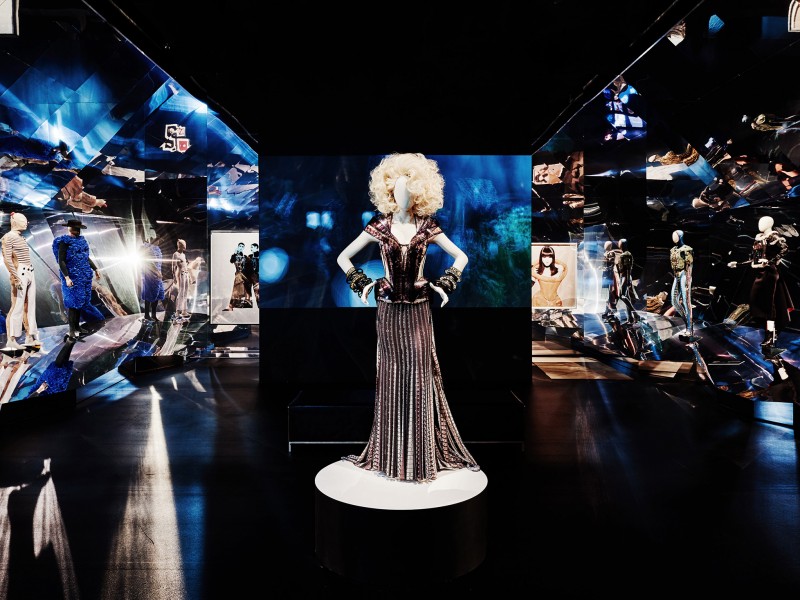“Art is humans doing their best.” So declares Barry X Ball, seated at his computer for our Skype interview, his shelves neatly stacked with papers, a series of printouts resembling cranial cross-sections pinned to the wall behind him. Ball has recently returned from Madrid, Spain where he has been finalising work on his largest piece to date, Perfect Forms. This three-metre-tall striding figure, cast in brass and steel and coated in mirror-polished 24 karat gold, is a reinterpretation of Umberto Boccioni’s iconic futurist sculpture, Unique Forms of Continuity in Space, first exhibited in 1913. In revisiting and retitling the work, Ball provides an effective encapsulation of his creative philosophy: the notion of art as something—anything—that people do “at the highest level”. Within this appealingly open-ended definition, creativity is framed as a process of improvement, as a continuous and often collaborative striving toward perfection.
From his early career as a conceptual artist working across numerous media, Ball’s practice has, over the past decade, evolved into something more specialised, identifiable by its fetishistic attention to craftsmanship and to detail. Employing a variety of rare and experimental materials, in combination with emerging digital and industrial technologies, Ball reinterprets traditional figurative sculpture to produce works that are at once historicised and unmistakably of their period. His methods range from time-honoured techniques of hand carving and polishing, to 3D scanning, virtual modelling, and computer-controlled cutting and milling. The ideal of perfection—of the best materials, the best techniques, the best makers, the best and most refined forms—underpins every aspect of Ball’s practice, from his reinterpretations of classical, baroque and futurist sculpture to his extraordinary, manipulated portrait busts of contemporary artists.
In the case of Perfect Forms, the original surface of Boccioni’s work has been smoothed, its angles sharpened, nicks and scratches have been repaired and the mirrored finish has been added so that the work, quite literally, reflects the world around it. The aerodynamic, fluid form of the original sculpture was intended to convey the speed and dynamism of the emergent machine age, and this spectre of modernity is thus perhaps uniquely suited to re-interpretation within the context of 21st century technologies.
The notion of revisiting an historical work for a contemporary audience is of course not a recent one. There exist countless later versions of classical, renaissance and baroque works, whose alterations and adaptations over the centuries might provide a prototype here. Ball’s ongoing Masterpieces series, begun in 2008, of which Perfect Forms is a part, takes as its unifying theme the difficult task of making new sculptures that are ‘more perfect’ than their purportedly ‘perfect’ historical prototypes. These productions are thus at once skeptical and optimistic, challenging the sacrosanct nature of their historic forbears, and simultaneously laying a clear path for contemporary and future artists: within this context, new works based upon older ones are not so much copies as upgrades.
Purity (2008-2011) was inspired by Antonio Corradini’s 18th century bust of the same name, popularly known as the Veiled Woman. This sculpture has, since its creation, been subject to countless re-imaginings, and Ball’s work thus forms the current telos in the work’s long history of reinvention. In the 19th century, the sculptor Raffaele Monti produced a highly successful, if rather less mystical variation on the work, adding a wreath of flowers around the head and subtly altering and softening the facial features in accordance with a mid-19th century taste for prettiness. Shortly thereafter, the Copeland pottery mass-produced a Parian copy of Monti’s sculpture, (now titled The Bride, in keeping with Victorian sentiment), which soon came to adorn countless middle-class mantelpieces.
Ball exhibits a very different set of motivations in his alterations to Corradini’s original form 150 years later. In his multiple versions of Purity, the most immediately apparent shift is in the material itself, where traditional white Carrara marble has been replaced by a variety of coloured stones, each with a differing level of opacity. These range from a delicate rose-tinted Iranian onyx, with all the luminous fragility of a sea-shell, to a rich and oily Belgian black marble. Each sculpture is created in-the-round, with even its underside meticulously polished, thereby eliminating the unfinished sections common to Corradini’s original and the aforementioned later copies, and making possible new modes of display. In his description of the work, Ball refers to “correcting” the damages that have occurred over time—filling in chips, scratches and scuffs. The veil has been extended and its lace border removed to enhance the liquidity of the form, and in another particularly sensuous detail, Ball has polished the small section of exposed skin to contrast with the matte surface of the veil.
One might question whether Ball’s alterations hold particular cultural or political significance for his own period, or whether the overarching ideal of aesthetic perfection transcends notions of historical specificity. Ball has spoken about his elimination of religious imagery from Purity—as such the sculpture is both secularised and made universal, better available for subjective interpretation. More playfully, he also points out that he has subtly enlarged the figure’s breasts, amplifying what he describes as the “veiled yet overt sensuality” already present in Corradini’s work. Common to all of Ball’s alterations is an aura of sensitivity to the apparent intentions of the prototype’s creator. Ball explains that in the case of another work from this series, The Sleeping Hermaphrodite, the entire lower portion of the face in the classical sculpture is unfinished, and he has thus stepped in where the original sculptor (perhaps for lack of time or funds) was unable to perfect his own project.
There is undoubtedly a departure from tradition inherent in these kinds of alterations; in the case of the majority of historical versions or copies, the quality diminishes with each successive work. Broadly speaking, the process of democratisation—of making works more available and more accessible—effectively compromises workmanship, employing cheaper materials, less specialised techniques and less skilled makers. What Ball endeavours to provide is, in effect, the inverse of this established paradigm, a deliberate and disciplined process of evolution rather than diminishment or simplification.
To achieve these results, Ball relies upon an extensive support system. Integral to this is his revival of the studio model, whereby much of the work is carried out by meticulously trained assistants, specialising in different aspects of the process, from 3D scanning and printing to hand carving and sanding. The 5000 hours of human labour it took to produce and refine The Sleeping Hermaphrodite would simply not have been achievable by an artist working alone. Prior to the mid-19th century, the tradition of the artist’s studio, (within which artisans were employed under the instruction of a master) was responsible for the creation of the majority of the world’s most celebrated artworks, and it seems fitting that Ball’s practice, with its emphasis upon refinement and faultless execution, should reinstate artisanal modes of production. Many of Ball’s assistants are practicing artists in their own right, and he speaks at length about the importance of inspiring them to produce the finest quality work, inside his studio and out of it. Old-fashioned patronage has also played a significant role in the development of Ball’s sculpture. Major patrons, including famed art collector Giuseppe Panza, have enabled Ball’s employment of assistants, his investment in new technologies, and the travel necessary not only to explore artistic prototypes, but to source the finest raw materials in which to reinterpret these.
Much of the impact of Ball’s sculpture resides in the quality of his materials, and his unconventional choice of stones is among the most innovative aspects of his practice. These are sourced from quarries around the world, and Ball—who is meticulous about individually selecting his stones and being present when they are first cut—describes the process as one that facilitates “the best connection to nature”. Many of these stones behave in very different ways from traditional white Italian marble, and there is consequently an exciting element of trial and error in achieving the final result. In the case of Mexican onyx, for example—one of Ball’s favoured materials—the veins, seams and pits that run through the stone materialize only as it is cut. Ball explains this element of serendipity as one of the more exciting aspects of his process, “I like the fact that there’s something out of control—it adds a kind of wildcard content to it”.
This effect is employed to particularly dramatic, symbolic effect in Envy (2008-2011), based upon Giusto Le Court’s Baroque masterpiece, La Invidia. Here, the cratered, diseased appearance of the stone mirrors the corruption of the subject. The geode craters resemble the stretched, distorted orifices of the face itself, their crystalized interiors simultaneously evoking decoration and decay. Crimson veins in the stone suggest an appropriately unbalanced circulatory system for the monstrous figure.
Perhaps the most aesthetically radical of Ball’s stone carvings feature the visages of fellow contemporary artists, manipulated and distorted and rendered in seductively tactile materials. These works, the majority of which are accompanied by extensive, poetic, playful and often indelicate titles, are seemingly Ball’s most experimental and in many cases his most visually unsettling. Employing sophisticated digital imaging software to manipulate the cast and scanned heads, he impales, stretches, pierces and flays his subjects. The artist also makes mirroring a feature of many of these portraits, lending a subtle element of strangeness to otherwise familiar faces.
Ball’s portrait bust of artist Matthew McCaslin (informally referred to as Homunculus 2000-2004) takes the form of an amoeba-like creature, rendered in a seemingly gelatinous translucent Mexican onyx, with tiny arms outstretched, Christ-like, beneath a bulging cranium. In an incongruously endearing detail, the arms were cast from Ball’s own infant daughter. The strange, metamorphic form is evocative of fin de siècle symbolist works such as Audrey Beardsley or Edvard Munch’s feotuses in jars and Odilon Redon’s series of charcoal noirs in all of their dark, degenerate glory. In a 2007 lecture addressing his portraiture, Ball discussed the technical aspects of his often violent alterations to the visages of artist friends, concluding with the suggestive declaration “and then there is the question of intent”. It is a question which Ball, teasingly, leaves unanswered.
In Ball’s self-portrait with Matthew Barney (2000-2007), the two artists have been brutally martyred and fused at the scalp, presented as severed, impaled double-heads, one face screaming the other pensive, flayed skin trailing down the steel spikes that support/pierce them. The element of grotesque is further complicated by the use of surface decoration which, Ball explains “is intended to evoke tattoos, tribal scarification, patterned armour…” Yet there is also, in the richly patterned surface, the suggestion of a kind of bourgeois domesticity. Ball describes his preference for Victorian patterns, notable, he explains for their “a-historical, multi-era, multi-style, ‘proto postmodern’ density”. And while there is manifestly a symbolic, self-referential element in this visual allusion to the Victorian magpie-like enthusiasm for historical borrowing, it is hard not to be distracted by the prettiness of the effect.
Related Features
-
54
-
-
-

